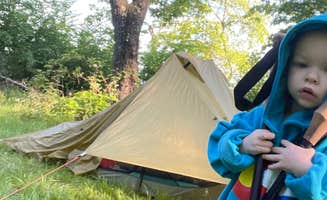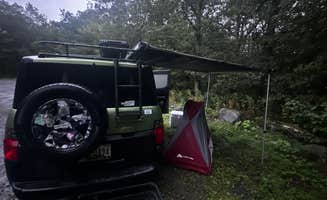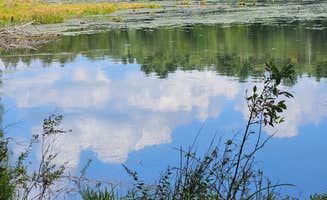Dispersed camping near Delaware Water Gap, Pennsylvania offers rustic, primitive camping experiences across state forest lands and along the Appalachian Trail corridor. The region sits at the boundary of the Pocono Mountains and Delaware River Valley, with elevations ranging from 300 to 1,600 feet. Winter temperatures regularly drop below freezing, with summer highs typically reaching the upper 80s, requiring campers to prepare for seasonal conditions.
What to do
Explore ridge viewpoints: The Bake Oven Knob area provides both overnight parking and access to scenic overlooks. "The hike to the overlook is really lovely; short and rocky," notes a camper at Bake Oven Knob. This high point on Blue Mountain ridge offers expansive views after a moderate climb.
Hike interconnected trail systems: Thunder Swamp Trailhead serves as a gateway to extensive hiking networks. According to one visitor, "Went down Saw Creek trail to a marsh," highlighting the diversity of terrain accessible from this location. The Thunder Swamp Trailhead connects to multiple trail loops suitable for day hikes or overnight backpacking.
Find lakeside solitude: Limited but scenic tent sites exist near water bodies in the region. "There are only 3 spots where we are. No motor vehicles beyond where I'm camping," reports a camper at Hickok Brook, emphasizing the small scale and privacy of these primitive lakeside accommodations.
What campers like
Natural separation between sites: The Appalachian Trail camping areas offer varying degrees of privacy. "We camped nearer to others but there are secluded spots too," notes a visitor at Appalachian Trail Designated Backpacker Campsite 2, indicating the flexibility to choose more social or isolated camping experiences.
Bear protection infrastructure: Some designated sites provide wildlife safety features. A camper mentions the campsite is "Well maintained w bear boxes provided," which adds security for food storage in this bear-active region.
Vehicle camping flexibility: Several trailhead parking areas permit overnight stays. "It's a gravel parking lot. Plenty of shade. No one bothered me," reports a visitor at Thunder Swamp Trailhead, indicating the simple but functional nature of vehicle-based camping options in the area.
What you should know
Limited water sources: Many campsites lack immediate access to drinking water. One camper notes, "I gave the site only four stars because there's no water nearby," and advises to "Stock up on water at the Dunnfield creek natural area, or wait until Sunfish pond."
Permit requirements vary by state: New York state land has specific permit regulations. A visitor at Hickok Brook learned this firsthand: "Where I originally camped was not a spot, according to Ranger. Had to move next to the lake. Need a permit on NY state land. Contact Rangers office of whatever county."
Road conditions challenge access: Many access roads require high-clearance vehicles. "The road is very rough with huge potholes so good clearance is a must," warns a Hickok Brook visitor, underscoring the importance of appropriate vehicle selection when accessing remote camping areas.
Tips for camping with families
Choose established backpacker sites: Designated areas provide more predictable camping conditions. A visitor notes that Appalachian Trail sites have "Good trees for hammocking," which can be particularly appealing for families with older children who enjoy alternative sleeping arrangements.
Prepare for complete self-sufficiency: No amenities exist at most locations. "Bring everything with you. It's a hike back to town," advises a camper at Hickok Brook, emphasizing the need for comprehensive packing when camping with children.
Consider holiday weekend crowding: Popular weekends see increased usage. "It's Labor Day weekend, see how many people try to cram in to the very limited camping area," observes one camper at Hickok Brook, suggesting families might prefer off-peak timing for a more relaxed experience.
Tips from RVers
Look for designated overnight parking: Some trailhead lots accommodate overnight vehicle stays. A visitor at Bake Oven Knob reports, "I've overnighted in my van here a bunch, no problems," confirming the viability of vehicle camping at select locations.
Limited options for larger rigs: Most areas cannot accommodate traditional RVs. "I drove in thinking that there would be flat places to park a very rugged camper in my full ton diesel pickup... It's not a good spot for car camping," cautions a visitor about expectations for vehicle size and camping style.
Consider van or truck camping: Smaller vehicles offer more flexibility in primitive camping areas. One visitor notes, "You can park and sleep, or hike in and find a place for a tent," highlighting the dual options available at some trailhead locations for those with compact camping vehicles.




